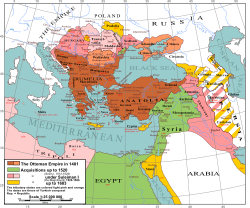Near East
The Near East is a large area of land in the eastern hemisphere. Countries of the eastern Mediterranean are part of the Near East. The name of the Near East comes from its position to the east of Europe and to the west of the Middle East and the Far East.[1][2]
The Levant, Mesopotamia, Anatolia, Iran, and Egypt are all regions that are part of the Near East.[3] In the past, the Balkan Peninsula, south-west Asia, and northern Africa were part of the Near East as well.[2] The Near East is also a name for Middle East which archaeologist, geographer and historian use.
Background
The term Near East came into use in the 1890s, when European powers had to deal with two critical situations in the "east".[4] The Sino-Japanese War in 1894–1895 in the Far East, and the Armenian Genocide in the Near East.[4]
British archaeologist D.G. Hogarth published The Nearer East in 1902, which helped to define the term and its extent, including Albania, Montenegro, southern Serbia and Bulgaria, Greece, Egypt, all the Ottoman lands, the entire Arabian peninsula, and western parts of Iran.[4]
Near East Media
At the height of its power (1683), the Ottoman Empire controlled territory in the Near East and North Africa, as well as Central and Southeastern Europe.
Ottoman Porte, 1767, gateway to trade with the Levant. Painting by Antoine de Favray.
References
- ↑ Everett-Heath, John (2020). "Near East, The". Concise Oxford Dictionary of World Place Names (6th ed.). Oxford University Press. doi:10.1093/acref/9780191905636.001.0001. ISBN 978-0-19-190563-6.
- ↑ 2.0 2.1 "Middle East, n.". Oxford English Dictionary Online (3rd ed.). Oxford University Press. 2018 [2003].
- ↑ Howatson, M. C., ed. (2011). "Near East". The Oxford Companion to Classical Literature. Oxford University Press. doi:10.1093/acref/9780199548545.001.0001. ISBN 978-0-19-954854-5.
- ↑ 4.0 4.1 4.2 Davidson, Roderic H. (1960). "Where is the Middle East?". Foreign Affairs. 38 (4): 665–675. doi:10.2307/20029452. JSTOR 20029452.








